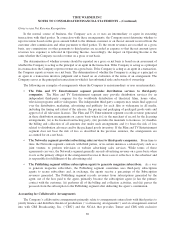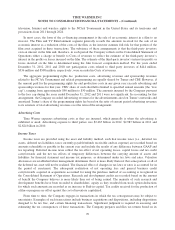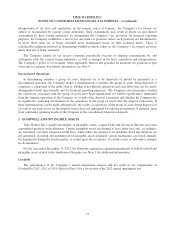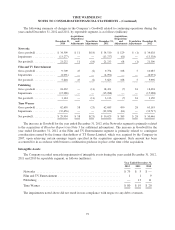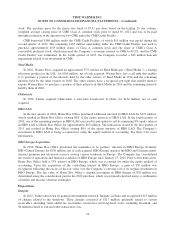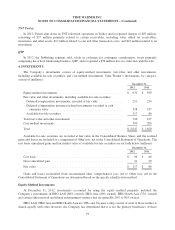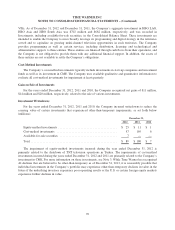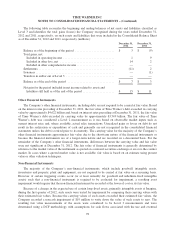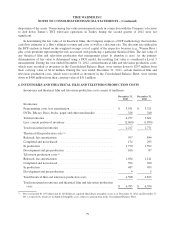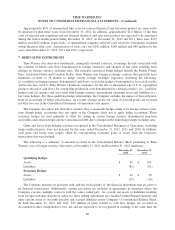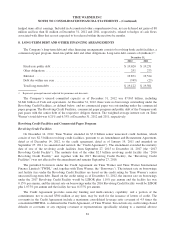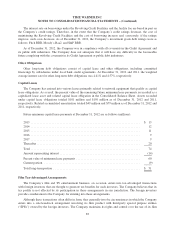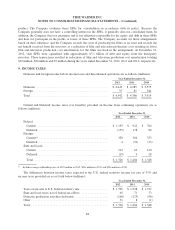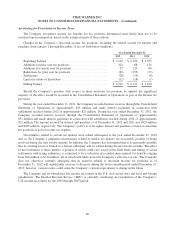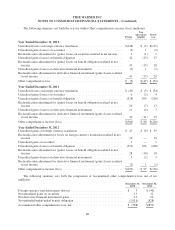Time Magazine 2012 Annual Report Download - page 94
Download and view the complete annual report
Please find page 94 of the 2012 Time Magazine annual report below. You can navigate through the pages in the report by either clicking on the pages listed below, or by using the keyword search tool below to find specific information within the annual report.
TIME WARNER INC.
NOTES TO CONSOLIDATED FINANCIAL STATEMENTS – (Continued)
The following table reconciles the beginning and ending balances of net assets and liabilities classified as
Level 3 and identifies the total gains (losses) the Company recognized during the years ended December 31,
2012 and 2011, respectively, on such assets and liabilities that were included in the Consolidated Balance Sheet
as of December 31, 2012 and 2011, respectively (millions):
December 31,
2012
December 31,
2011
Balance as of the beginning of the period .......................... $ 3 $ (9)
Total gains, net:
Included in operating income .................................. 1 9
Included in other loss, net .................................... 14 2
Included in other comprehensive income ......................... — —
Settlements .................................................. (11) 2
Issuances .................................................... — (1)
Transfers in and/or out of Level 3 ................................ — —
Balance as of the end of the period ............................... $ 7 $ 3
Net gain for the period included in net income related to assets and
liabilities still held as of the end of the period ..................... $ 15 $ 11
Other Financial Instruments
The Company’s other financial instruments, including debt, are not required to be carried at fair value. Based
on the interest rates prevailing at December 31, 2012, the fair value of Time Warner’s debt exceeded its carrying
value by approximately $4.622 billion and, based on interest rates prevailing at December 31, 2011, the fair value
of Time Warner’s debt exceeded its carrying value by approximately $3.549 billion. The fair value of Time
Warner’s debt was considered a Level 2 measurement as it was based on observable market inputs such as
current interest rates and, where available, actual sales transactions. Unrealized gains or losses on debt do not
result in the realization or expenditure of cash and generally are not recognized in the consolidated financial
statements unless the debt is retired prior to its maturity. The carrying value for the majority of the Company’s
other financial instruments approximates fair value due to the short-term nature of the financial instruments or
because the financial instruments are of a longer-term nature and are recorded on a discounted basis. For the
remainder of the Company’s other financial instruments, differences between the carrying value and fair value
were not significant at December 31, 2012. The fair value of financial instruments is generally determined by
reference to the market value of the instrument as quoted on a national securities exchange or an over-the-counter
market. In cases where a quoted market value is not available, fair value is based on an estimate using present
value or other valuation techniques.
Non-Financial Instruments
The majority of the Company’s non-financial instruments, which include goodwill, intangible assets,
inventories and property, plant and equipment, are not required to be carried at fair value on a recurring basis.
However, if certain triggering events occur (or at least annually for goodwill and indefinite-lived intangible
assets) such that a non-financial instrument is required to be evaluated for impairment, a resulting asset
impairment would require that the non-financial instrument be recorded at the lower of cost or its fair value.
Because of a change in the expected use of certain long-lived assets, primarily intangible assets at Imagine,
during the first quarter of 2012, such assets were tested for impairment by comparing their carrying values with
their estimated fair values. Because the carrying values of such assets exceeded their estimated fair values, the
Company recorded a noncash impairment of $19 million to write down the value of such assets to zero. The
resulting fair value measurements of the assets were considered to be Level 3 measurements and were
determined using a DCF methodology with assumptions for cash flows associated with the use and eventual
78



